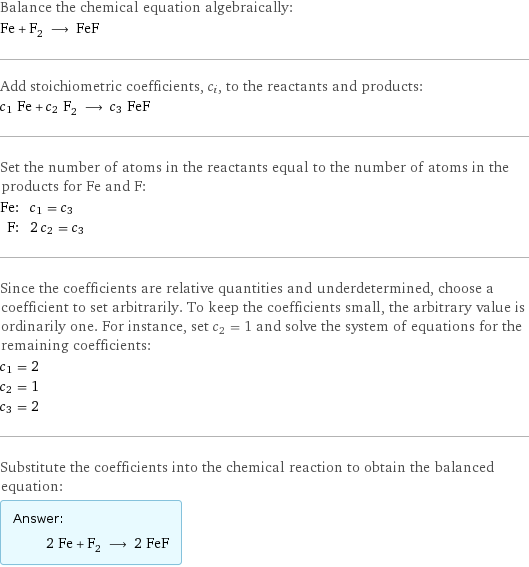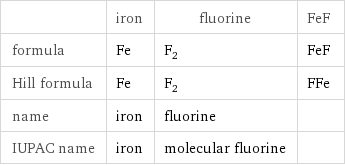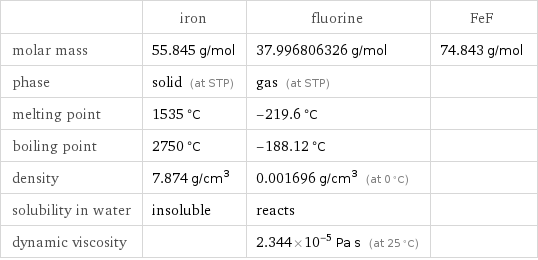Input interpretation

Fe iron + F_2 fluorine ⟶ FeF
Balanced equation

Balance the chemical equation algebraically: Fe + F_2 ⟶ FeF Add stoichiometric coefficients, c_i, to the reactants and products: c_1 Fe + c_2 F_2 ⟶ c_3 FeF Set the number of atoms in the reactants equal to the number of atoms in the products for Fe and F: Fe: | c_1 = c_3 F: | 2 c_2 = c_3 Since the coefficients are relative quantities and underdetermined, choose a coefficient to set arbitrarily. To keep the coefficients small, the arbitrary value is ordinarily one. For instance, set c_2 = 1 and solve the system of equations for the remaining coefficients: c_1 = 2 c_2 = 1 c_3 = 2 Substitute the coefficients into the chemical reaction to obtain the balanced equation: Answer: | | 2 Fe + F_2 ⟶ 2 FeF
Structures

+ ⟶ FeF
Names

iron + fluorine ⟶ FeF
Equilibrium constant
![Construct the equilibrium constant, K, expression for: Fe + F_2 ⟶ FeF Plan: • Balance the chemical equation. • Determine the stoichiometric numbers. • Assemble the activity expression for each chemical species. • Use the activity expressions to build the equilibrium constant expression. Write the balanced chemical equation: 2 Fe + F_2 ⟶ 2 FeF Assign stoichiometric numbers, ν_i, using the stoichiometric coefficients, c_i, from the balanced chemical equation in the following manner: ν_i = -c_i for reactants and ν_i = c_i for products: chemical species | c_i | ν_i Fe | 2 | -2 F_2 | 1 | -1 FeF | 2 | 2 Assemble the activity expressions accounting for the state of matter and ν_i: chemical species | c_i | ν_i | activity expression Fe | 2 | -2 | ([Fe])^(-2) F_2 | 1 | -1 | ([F2])^(-1) FeF | 2 | 2 | ([FeF])^2 The equilibrium constant symbol in the concentration basis is: K_c Mulitply the activity expressions to arrive at the K_c expression: Answer: | | K_c = ([Fe])^(-2) ([F2])^(-1) ([FeF])^2 = ([FeF])^2/(([Fe])^2 [F2])](../image_source/9836fe5891cf25940f61032003927b18.png)
Construct the equilibrium constant, K, expression for: Fe + F_2 ⟶ FeF Plan: • Balance the chemical equation. • Determine the stoichiometric numbers. • Assemble the activity expression for each chemical species. • Use the activity expressions to build the equilibrium constant expression. Write the balanced chemical equation: 2 Fe + F_2 ⟶ 2 FeF Assign stoichiometric numbers, ν_i, using the stoichiometric coefficients, c_i, from the balanced chemical equation in the following manner: ν_i = -c_i for reactants and ν_i = c_i for products: chemical species | c_i | ν_i Fe | 2 | -2 F_2 | 1 | -1 FeF | 2 | 2 Assemble the activity expressions accounting for the state of matter and ν_i: chemical species | c_i | ν_i | activity expression Fe | 2 | -2 | ([Fe])^(-2) F_2 | 1 | -1 | ([F2])^(-1) FeF | 2 | 2 | ([FeF])^2 The equilibrium constant symbol in the concentration basis is: K_c Mulitply the activity expressions to arrive at the K_c expression: Answer: | | K_c = ([Fe])^(-2) ([F2])^(-1) ([FeF])^2 = ([FeF])^2/(([Fe])^2 [F2])
Rate of reaction
![Construct the rate of reaction expression for: Fe + F_2 ⟶ FeF Plan: • Balance the chemical equation. • Determine the stoichiometric numbers. • Assemble the rate term for each chemical species. • Write the rate of reaction expression. Write the balanced chemical equation: 2 Fe + F_2 ⟶ 2 FeF Assign stoichiometric numbers, ν_i, using the stoichiometric coefficients, c_i, from the balanced chemical equation in the following manner: ν_i = -c_i for reactants and ν_i = c_i for products: chemical species | c_i | ν_i Fe | 2 | -2 F_2 | 1 | -1 FeF | 2 | 2 The rate term for each chemical species, B_i, is 1/ν_i(Δ[B_i])/(Δt) where [B_i] is the amount concentration and t is time: chemical species | c_i | ν_i | rate term Fe | 2 | -2 | -1/2 (Δ[Fe])/(Δt) F_2 | 1 | -1 | -(Δ[F2])/(Δt) FeF | 2 | 2 | 1/2 (Δ[FeF])/(Δt) (for infinitesimal rate of change, replace Δ with d) Set the rate terms equal to each other to arrive at the rate expression: Answer: | | rate = -1/2 (Δ[Fe])/(Δt) = -(Δ[F2])/(Δt) = 1/2 (Δ[FeF])/(Δt) (assuming constant volume and no accumulation of intermediates or side products)](../image_source/9f396ed919250bb51c5613b26d3c76ec.png)
Construct the rate of reaction expression for: Fe + F_2 ⟶ FeF Plan: • Balance the chemical equation. • Determine the stoichiometric numbers. • Assemble the rate term for each chemical species. • Write the rate of reaction expression. Write the balanced chemical equation: 2 Fe + F_2 ⟶ 2 FeF Assign stoichiometric numbers, ν_i, using the stoichiometric coefficients, c_i, from the balanced chemical equation in the following manner: ν_i = -c_i for reactants and ν_i = c_i for products: chemical species | c_i | ν_i Fe | 2 | -2 F_2 | 1 | -1 FeF | 2 | 2 The rate term for each chemical species, B_i, is 1/ν_i(Δ[B_i])/(Δt) where [B_i] is the amount concentration and t is time: chemical species | c_i | ν_i | rate term Fe | 2 | -2 | -1/2 (Δ[Fe])/(Δt) F_2 | 1 | -1 | -(Δ[F2])/(Δt) FeF | 2 | 2 | 1/2 (Δ[FeF])/(Δt) (for infinitesimal rate of change, replace Δ with d) Set the rate terms equal to each other to arrive at the rate expression: Answer: | | rate = -1/2 (Δ[Fe])/(Δt) = -(Δ[F2])/(Δt) = 1/2 (Δ[FeF])/(Δt) (assuming constant volume and no accumulation of intermediates or side products)
Chemical names and formulas

| iron | fluorine | FeF formula | Fe | F_2 | FeF Hill formula | Fe | F_2 | FFe name | iron | fluorine | IUPAC name | iron | molecular fluorine |
Substance properties

| iron | fluorine | FeF molar mass | 55.845 g/mol | 37.996806326 g/mol | 74.843 g/mol phase | solid (at STP) | gas (at STP) | melting point | 1535 °C | -219.6 °C | boiling point | 2750 °C | -188.12 °C | density | 7.874 g/cm^3 | 0.001696 g/cm^3 (at 0 °C) | solubility in water | insoluble | reacts | dynamic viscosity | | 2.344×10^-5 Pa s (at 25 °C) |
Units
